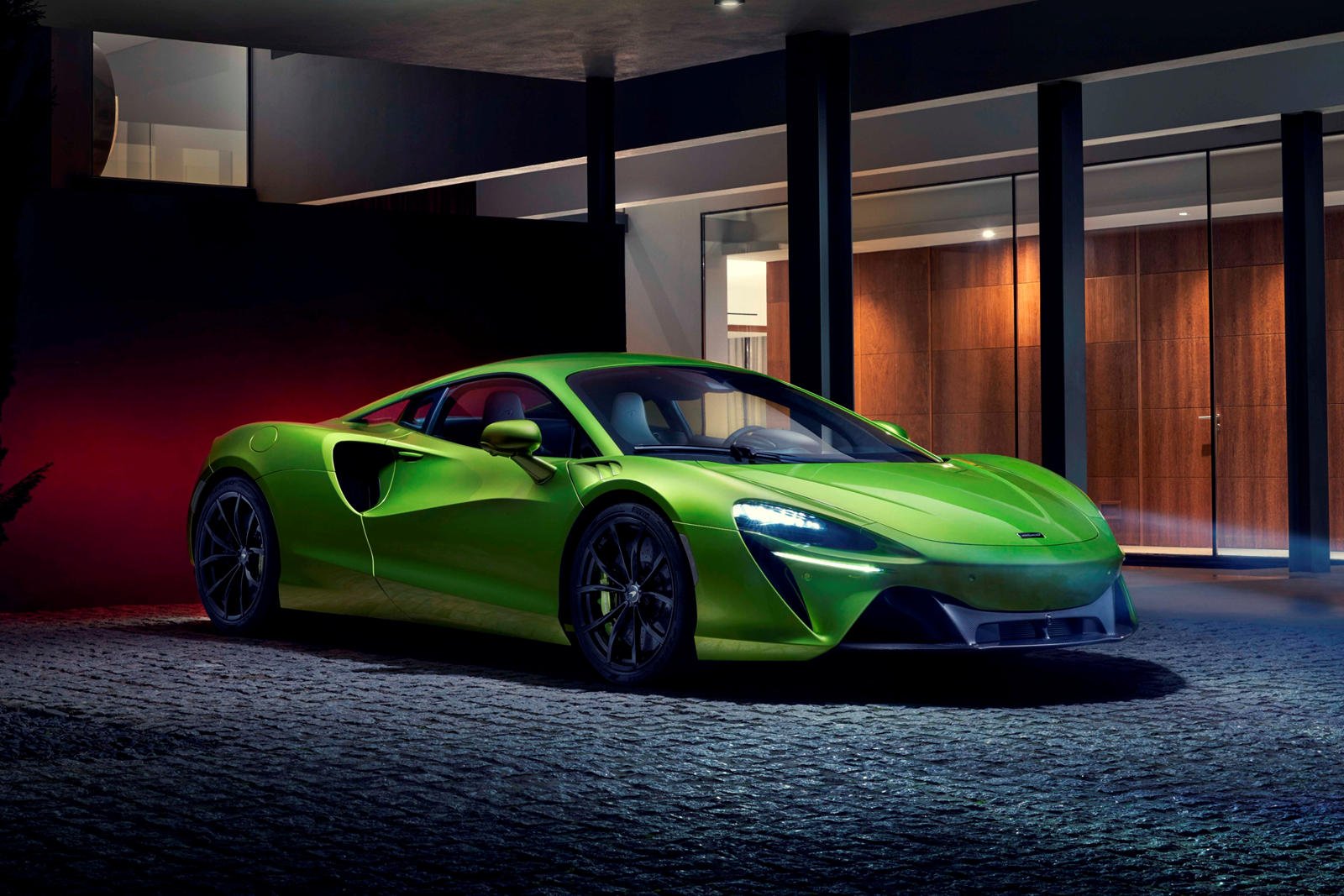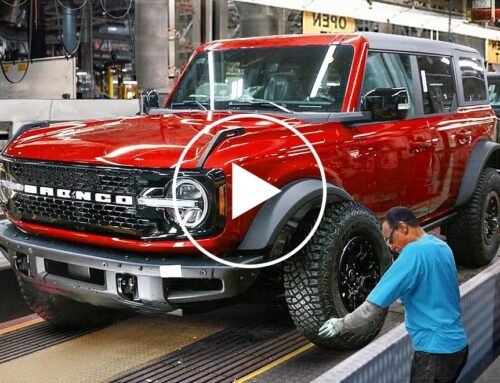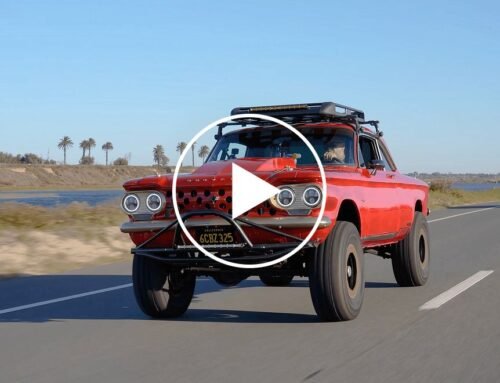The high-performance plug-in hybrid supercar from McLaren is here.
Until now, if you wanted a hybrid supercar from McLaren, it would cost you upwards of $2 million for the Speedtail – and it’s not even street-legal in the USA. The Speedtail is a showcase of McLaren’s hybrid engineering development, but it’s time for that technology to trickle down into more accessibly-priced production models. The McLaren Artura is officially the first “High-Performance Hybrid” series-production supercar from the British marque, powered by a twin-turbocharged V6 engine and an electric motor combining to generate a total of 671 hp and 530 lb-ft of torque. The problem with McLaren going hybrid is that it goes against the British marque’s mantra of lightness. To offset the extra weight from batteries and a motor, the Artura is the first model to be built on the all-new in-house designed and built McLaren Carbon Lightweight Architecture (MCLA). There’s been a lot to drink in with the Artura’s reveal, so we’re going to unpack it and take a look at some of the plug-in hybrid supercar’s coolest features.
 McLaren
McLaren
 McLaren
McLaren
 McLaren
McLaren
 McLaren
McLaren
Power-To-Weight: 481 Horsepower Per Ton
All that power means nothing if you’re carrying a lot of weight. There’s no single answer to creating a plug-in hybrid weighing just 3,075 lbs; that weight is measured without fluids, but it’s still incredible. Making the Artura as light as possible starts with the all-new carbon fiber chassis and gets as pedantic as shaving ten percent of weight from the electrical cabling system. McLaren said some time ago it wouldn’t build an electric car until batteries were light enough; well that day is fast approaching, as the battery pack weighs just 195 lbs while the electric motor comes in at 34 lbs. McLaren shunned its usual V8 for the all-new dry-sump turbo V6 and saved a further 110 lbs doing so, resulting in a supercar that’s a featherweight despite its electric augmentation.
Next-Level Drivetrain: Goodbye Cylinders, Hello Electricity
The dry-sump, twin-turbocharged V6 was designed from scratch specifically for the Artura, along with the twin-clutch short-ratio transmission that includes the electric motor in the bell housing. The electric motor is mainly used for torque-fill and provides an extra 94 horsepower but, more importantly, 166 lb-ft of instant torque. Matched to the 577 hp and 431 lb-ft of torque from the piston engine, it propels the Artura to 62 mph in 3.0 seconds, 124 mph in 8.3 seconds, and 186 mph in 21.5 seconds. It’s not just about straight-line speed, though. The new eight-speed dual-clutch transmission has 200-millisecond gear changes, features McLaren’s first electronic differential, and more weight is saved by not having a reverse gear. Instead, backing up the Artura is done purely under electrical propulsion.
On top of the crazy performance, McLaren also claims 50 mpg using the WLTP measuring cycle, which should convert to around 40 mpg when it goes through EPA verification.
Reinventing The Rear Suspension
McLaren is a company of engineers, and that means that when it’s prudent, they’re going to reinvent something. In this case, it’s the rear suspension. Essentially, the engineers and geometry nerds have split in the lower wishbone in two to create a multi-link component. Now we’re going to oversimplify what looks like a piece of engineering wizardry as we understand it. First, we need to explain that ‘toe’ is the angle the wheels are turned in or outwards, while camber is the angle at which the wheels lean in or out at the top.
The multi-link wishbone maximizes the distance between the upright and toe (tracking), which increases the toe stiffness. The uprights are stiffened to increase camber strength. This is important as any flex changes the tracking settings. For example, toe-in is used for straight-line stability, so any flex under hard acceleration will upset that.
Then, seemingly just to show off, the wrinkle-brains at McLaren used the new setup to shave another 5.3 lbs of unsprung mass on each side of the car, making it lighter and more stable all in one shot.
 McLaren
McLaren
 McLaren
McLaren
 McLaren
McLaren
 McLaren
McLaren
Even More Suspension Wizardry
The suspension is where the magic happens. It’s where the grip and handling are created, and McLaren’s Proactive Damping Control system is the centerpiece. The Artura uses single-stiffness springs and mechanical anti-roll bars, presumably for the sake of simplicity and weight saving, then packs a ton of sophistication into its dampers. The units are “continuously variable, twin-valve hydraulic dampers that feature individual compression and rebound characteristics.”
Dampers damp, as in control, the spring’s movement, and McLaren’s are controlled by its latest Optimal Control Theory software algorithm based on sensors “reading” the road. The sensors are made up of four individual wheel accelerometers, three body accelerometers, and two pressure sensors per damper. Then multiple sensors measuring steering angle, vehicle speed, yaw rate, and lateral acceleration. That’s a huge amount of information for algorithms to compute on the fly, however, McLaren claims the data is processed in less than two milliseconds to use the software’s digital models to predict the perfect damping response.
 McLaren
McLaren
 McLaren
McLaren
 McLaren
McLaren
 McLaren
McLaren
Slider-Controlled Oversteer
Here’s what happens: You sit in your McLaren Artura. You start the engine and, while it starts to warm up, you consider how sideways you want to go today. Once you’ve decided, you touch the screen and use a slider to set the Variable Drift Control (VDC). What you’re doing is adjusting the level of traction control assistance while the E-diff takes in a ton of data like corner radius, vehicle speed, and damping characteristics and accordingly controls the torque split between the rear wheels. McLaren describes it as “constantly fine-tuning the Artura’s agility/stability attitude to benefit a driver drifting the car on a track or controlling yaw gain with the throttle.” We describe it as drift mode and suspect the biggest fan of it following newborn drift heroes will be Pirelli, who will happily sell Artura owners replacement P Zero tires for as long as said owners are willing to cough up.
Cyber-Connected Tires As Sensors
The McLaren Artura comes with three tire choices tailored for the car by Pirelli. The choice is between the standard P Zero performance road tire, the P Zero Corsa road and track tire, and the P Zero Winter tire. But regardless of which you opt for, they’re all fitted with Pirelli’s Cyber Tire system, which consists of a sensor chip in each tire and software to create a stream of data for the car to use. That includes real-time monitoring of the tire’s temperature and pressure levels and helps the car deliver the best tire performance possible. The sensors also distinguish between the different tires and create the information relevant to that tire.
 McLaren
McLaren
 McLaren
McLaren
 McLaren
McLaren
 McLaren
McLaren
Daily-Driver Technology
McLaren delivers hardcore performance vehicles, but the Artura is designed to be driven every day. That’s reflected in the driver assistance technology that comes as standard, and for the first time in a McLaren product. The features include adaptive cruise control that also works in stop-start traffic, road sign recognition, lane departure warning, and high-beam assist. The digital instrument cluster is mounted on the steering column, so its position changes with the steering wheel so it can’t be obscured. However, there are no controls on the steering wheel as McLaren believes its “sole function is to steer the car and provide feedback to the driver.”
The infotainment system is Google Android-based and controlled by an eight-inch portrait screen. Android Auto and Apple CarPlay are standard functions, and the system boots up when it detects the driver’s phone via Bluetooth as they approach, a function that also serves to unlock the door. The system also works in reverse, meaning the driver never has to think about locking and unlocking the car again unless they forget their phone.
 McLaren
McLaren
 McLaren
McLaren
 McLaren
McLaren
 McLaren
McLaren
 McLaren
McLaren
 McLaren
McLaren





